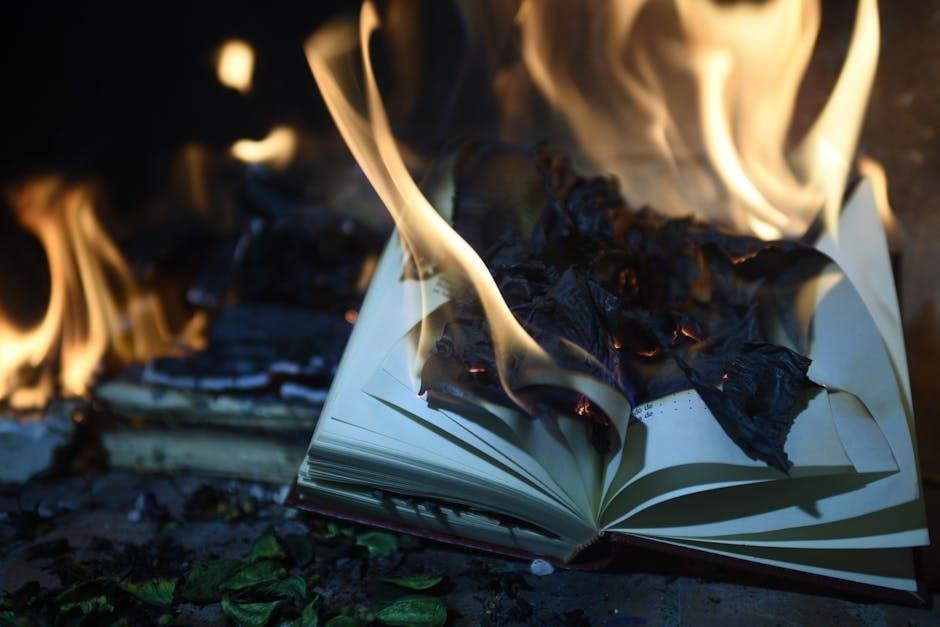
Catching Fire‚ the second installment in The Hunger Games trilogy‚ explores Katniss Everdeen’s journey as the face of a burgeoning rebellion in a dystopian world.
Background and Context of the Book
Catching Fire‚ the second installment in The Hunger Games trilogy‚ is set in the dystopian nation of Panem. The story unfolds after Katniss Everdeen and Peeta Mellark’s victory in the 74th Hunger Games‚ which inadvertently ignites the flames of rebellion across the oppressed districts. The Capitol‚ fearing the growing dissent‚ tightens its grip‚ forcing Katniss into a delicate political game. The book explores themes of oppression‚ survival‚ and the moral complexities of war‚ all while maintaining a thrilling narrative that keeps readers engaged. Suzanne Collins masterfully weaves historical and cultural undertones‚ reflecting real-world struggles for freedom and justice‚ making the story both timeless and deeply resonant.
Historical and Cultural Relevance
Catching Fire draws parallels to historical events like the Roman Empire’s gladiatorial games and modern-day reality TV‚ highlighting humanity’s dark fascination with voyeuristic entertainment. The oppressive regime of Panem mirrors totalitarian regimes‚ offering a cautionary tale about government control. The book resonates culturally as it reflects contemporary issues such as income inequality‚ media manipulation‚ and the exploitation of the poor by the wealthy. Suzanne Collins uses these themes to critique societal norms‚ making the story not only a thrilling narrative but also a commentary on human nature and the dangers of unchecked power and manipulation.
Overview of the Author‚ Suzanne Collins
Suzanne Collins is a renowned American author‚ best known for The Hunger Games trilogy. Her work often explores themes of survival‚ rebellion‚ and social injustice. Collins’ background in television writing influenced her storytelling style‚ making her novels vivid and engaging. Catching Fire showcases her ability to craft compelling characters and dystopian worlds‚ resonating with readers globally. Her writing reflects a deep understanding of human nature‚ blending action with profound emotional depth. Collins’ success has solidified her place in young adult literature‚ inspiring a devoted fan base and critical acclaim for her thought-provoking narratives.
Plot Summary of “Catching Fire”
Katniss Everdeen and Peeta Mellark are forced to participate in the 75th Hunger Games‚ igniting rebellion across Panem as President Snow tightens his oppressive grip.
Key Events in the Story
Catching Fire begins with Katniss Everdeen and Peeta Mellark embarking on a victory tour across Panem‚ aimed at quelling growing rebellion. However‚ their actions inadvertently ignite further defiance against the Capitol. The 75th Hunger Games introduces a shocking twist: previous victors‚ including Katniss and Peeta‚ are forced to compete again. The arena becomes a deadly trap‚ with alliances forming and betrayals unfolding. Katniss’s defiance reaches new heights‚ symbolized by the mockingjay pin‚ as she becomes the face of the rebellion. The story culminates in a dramatic escape‚ leaving Katniss in District 13‚ ready to lead the fight against oppression‚ while Peeta is captured by the Capitol.
Major Plot Twists and Turns
Catching Fire delivers several shocking plot twists‚ starting with the announcement of the Quarter Quell‚ which forces previous victors back into the arena. Katniss and Peeta must navigate this new‚ lethal challenge while maintaining their fabricated romance to garner public support. The arena itself is a masterfully designed death trap‚ with unpredictable dangers like blood rain and mandrills. A pivotal moment occurs when Katniss destroys the arena’s force field‚ allowing her and a few allies to escape. Meanwhile‚ District 13’s existence is revealed‚ and Katniss learns she has become the Mockingjay‚ the symbol of rebellion. Peeta’s capture by the Capitol leaves Katniss determined to rescue him‚ setting the stage for the next installment.
The Ending and Its Implications
Katniss’s decision to destroy the arena’s force field marks a turning point‚ allowing her escape but leaving Peeta in Capitol hands. This act solidifies her role as the Mockingjay‚ the face of the rebellion. The ending highlights Katniss’s internal conflict between survival and leadership‚ as she grapples with the moral weight of inspiring a revolution. Meanwhile‚ the destruction of District 12 and the rise of District 13 set the stage for an all-out war. The conclusion underscores the personal and political stakes‚ leaving readers eager to see Katniss’s next move in the fight against oppression.

Main Characters in “Catching Fire”
Katniss Everdeen‚ the protagonist‚ embodies rebellion and resilience. Peeta Mellark‚ her co-victor‚ hides his true feelings behind strategic smiles. President Snow represents oppressive authority‚ while others like Haymitch and Gale play pivotal roles.
Katniss Everdeen: The Protagonist
Katniss Everdeen‚ the protagonist of Catching Fire‚ is a complex and dynamic character whose actions drive the story. She is portrayed as strong-willed and independent‚ yet burdened by the weight of her responsibilities. As the face of the growing rebellion‚ Katniss struggles with the moral implications of her role‚ often finding herself torn between survival and the greater good. Her relationships‚ particularly with Peeta and Gale‚ add depth to her character‚ showcasing her vulnerability and humanity. Through her journey‚ Katniss evolves from a reluctant victor to a symbol of hope‚ embodying the spirit of resistance against oppression.
Peeta Mellark: The Co-Victor
Peeta Mellark‚ the co-victor of the 74th Hunger Games‚ is a central character whose role in Catching Fire deepens the narrative. His love for Katniss‚ though strategically revealed to gain sympathy‚ gradually becomes genuine. Peeta’s strength lies not in physical prowess but in his emotional resilience and artistic skills‚ which he uses to manipulate public perception. His willingness to sacrifice himself for Katniss underscores his devotion and moral courage. As the story unfolds‚ Peeta becomes a symbol of hope and a key player in the burgeoning rebellion‚ though his experiences leave him emotionally scarred. His relationship with Katniss remains complex‚ blending love‚ duty‚ and survival.
President Snow: The Antagonist
President Snow‚ the oppressive leader of Panem‚ serves as the primary antagonist in Catching Fire. His rule is marked by ruthlessness and manipulation‚ as he seeks to maintain the Capitol’s control over the districts. Snow is determined to crush the growing rebellion and eliminate Katniss Everdeen‚ who has become a symbol of hope for the oppressed. His actions are driven by a desire to preserve the Capitol’s power and quell dissent. Through intimidation‚ propaganda‚ and violence‚ Snow tightening his grip on Panem‚ making him a formidable and terrifying adversary. His presence underscores the themes of oppression and resistance central to the story.
Other Important Characters and Their Roles
Beyond Katniss and Peeta‚ several characters play pivotal roles in Catching Fire. Haymitch Abernathy‚ the former Hunger Games victor‚ serves as a mentor and strategist‚ helping Katniss and Peeta navigate the arena and political complexities. Effie Trinket‚ their eccentric escort‚ shows a deeper loyalty to the tributes despite her allegiance to the Capitol. Johanna Mason‚ a skilled and ruthless tribute from District 7‚ becomes a formidable ally and adversary‚ driven by her own motivations. Each character contributes to the intricate dynamics of rebellion‚ survival‚ and moral struggle‚ enriching the narrative with their unique perspectives and actions. Their roles are essential to the story’s progression and thematic depth.

Themes in “Catching Fire”
Catching Fire explores rebellion‚ survival‚ propaganda‚ and moral dilemmas‚ delving into themes of oppression‚ sacrifice‚ and the cost of war‚ resonating deeply with readers.
Rebellion Against Oppression
Catching Fire vividly portrays rebellion as Katniss becomes the Mockingjay symbol‚ igniting widespread defiance across districts. The Capitol’s oppressive regime is challenged through her actions and public defiance‚ highlighting the power of individual resistance to inspire collective change. The growing unrest reflects themes of freedom and justice‚ as Katniss’s role evolves from survivor to leader. This rebellion theme underscores the human spirit’s fight against tyranny‚ making the novel a powerful commentary on oppression and resistance‚ resonating with readers as a timeless struggle for liberty.
Survival and Its Moral Implications
In Catching Fire‚ survival is not just physical but also a moral battleground. Katniss’s actions in the arena force her to confront the ethical costs of staying alive. The oppressive Capitol’s manipulation of the Games compels tributes to make brutal choices‚ blurring the lines between right and wrong. Katniss’s use of the bow and arrow symbolizes her resourcefulness‚ yet the trauma of killing weighs heavily on her conscience. The novel explores the psychological toll of constant survival‚ as Katniss grapples with the moral consequences of her actions. This theme highlights the emotional and ethical struggles of enduring in a world designed to break humanity.
Propaganda and Media Manipulation
Propaganda and media manipulation are central to the Capitol’s control in Catching Fire. The Capitol uses the Hunger Games as a tool to suppress dissent‚ broadcasting carefully edited footage to portray tributes in a favorable light. Katniss’s public image is manipulated to serve the Capitol’s agenda‚ with her actions framed to either inspire fear or false hope. The Gamemakers’ strategic edits and Caesar Flickerman’s charismatic commentary shape public perception‚ creating a false narrative of the Games. This manipulation highlights the power of media in shaping reality and controlling the masses‚ a critical commentary on modern media influence and government propaganda tactics.
Moral Dilemmas and Hard Choices
In Catching Fire‚ Katniss faces numerous moral dilemmas‚ forced to choose between survival and the greater good. Her actions in the arena‚ such as sparing Mags and helping Peeta‚ reveal her internal conflict between self-preservation and compassion. The Quarter Quell twist intensifies these choices‚ as Katniss must decide whether to protect her allies or sacrifice herself for the rebellion. These decisions highlight the ethical complexity of war and leadership‚ as Katniss grapples with the consequences of her actions on a personal and societal level. Her struggles resonate deeply‚ illustrating the heavy burden of making sacrifices for others and the moral ambiguity of revolution.
The Cost of War and Revolution
Catching Fire vividly portrays the devastating cost of war and revolution‚ both personally and collectively. Katniss’s role as the Mockingjay symbol ignites rebellion across districts‚ leading to widespread destruction and loss of innocent lives. The toll on individuals is profound‚ as Katniss‚ Peeta‚ and their allies suffer physical and emotional trauma. The book highlights the moral and ethical sacrifices required to challenge oppressive regimes‚ emphasizing the high price of freedom and the lasting scars left by conflict; Through Katniss’s journey‚ Collins underscores the human cost of revolution‚ revealing the fragility of hope amidst chaos and the enduring impact on those who fight for change.
Symbols and Motifs in “Catching Fire”
Symbols and motifs play a crucial role in Catching Fire‚ enriching the narrative with deeper meanings. The Mockingjay symbolizes rebellion and hope‚ while fire represents both destruction and transformation. The arena serves as a constant reminder of oppression and control. These elements weave together to create a layered story that explores themes of resistance‚ survival‚ and the human spirit. Through these symbols‚ Suzanne Collins conveys the emotional and political undertones of the story‚ drawing readers deeper into Katniss’s world and the broader struggle against tyranny.
The Mockingjay as a Symbol of Rebellion
The Mockingjay symbolizes the heart of the rebellion in Catching Fire. It represents defiance and hope‚ embodying Katniss’s unintended role as the face of the uprising. The Mockingjay’s image‚ worn by Katniss and adopted by rebels‚ becomes a powerful unifying force against the oppressive Capitol. Its significance grows as Katniss realizes her actions in the arena and public appearances fuel the flames of dissent. The Mockingjay’s evolution from a personal token to a widespread emblem underscores the transformative power of symbols in driving social change and inspiring collective resistance against tyranny.
Fire as a Recurring Motif
Fire emerges as a potent motif in Catching Fire‚ symbolizing destruction‚ transformation‚ and the unquenchable spirit of rebellion. Katniss‚ often associated with flames‚ becomes the fiery catalyst for the growing uprising. The motif is evident in the arena’s treacherous firestorms and the symbolic burning of oppressive symbols. Fire also represents Katniss’s internal struggle‚ her passion for survival‚ and her role in igniting hope across Panem. This motif underscores the duality of fire as both a destructive force and a source of renewal‚ mirroring the chaos and change sweeping through the nation.
The Arena as a Symbol of Control
The arena in Catching Fire serves as a vivid symbol of the Capitol’s oppressive control over Panem. Designed to manipulate and dominate‚ the arena represents the oppressive regime’s ability to dictate reality and crush dissent. Its ever-changing landscapes and deadly traps mirror the Capitol’s ruthless strategies to maintain power. The Gamemakers’ control over the environment reflects the broader societal control exerted by the Capitol‚ forcing tributes into a brutal fight for survival. The arena also symbolizes the exploitation of fear and suffering for entertainment‚ highlighting the moral decay of the oppressive regime. Through this symbol‚ Collins critiques authoritarianism and its mechanisms of control.

Writing Style and Narrative Techniques
Suzanne Collins employs a gripping first-person narrative‚ immersing readers in Katniss’s thoughts and emotions. The book masterfully uses suspense and tension to maintain reader engagement throughout.
First-Person Narrative and Its Impact
The first-person narrative in Catching Fire immerses readers in Katniss’s intimate thoughts and emotions‚ creating a deep emotional connection. This perspective heightens tension and suspense‚ as readers experience events through Katniss’s lens. By limiting the narrative to her viewpoint‚ Collins builds a sense of immediacy and urgency‚ drawing readers into the high-stakes world of Panem. The personal struggles‚ fears‚ and motivations of Katniss are vividly portrayed‚ making her a relatable and compelling protagonist. This narrative choice also underscores the psychological toll of the Hunger Games‚ emphasizing Katniss’s internal conflict and the moral dilemmas she faces. The storytelling feels raw and unfiltered‚ enhancing the book’s emotional impact.
The Use of Suspense and Tension
Suzanne Collins masterfully crafts suspense and tension in Catching Fire‚ keeping readers on edge throughout Katniss’s perilous journey. The Quarter Quell twist and the return to the arena heighten anxiety‚ as the stakes grow exponentially. Collins employs cliffhangers‚ unexpected alliances‚ and relentless threats to maintain a gripping pace. The moral dilemmas Katniss faces‚ such as protecting loved ones while symbolizing rebellion‚ deepen the emotional strain. Tension is further amplified by the oppressive presence of the Capitol and the looming threat of President Snow. These elements collectively create a thrilling narrative that captivates readers and underscores the high-stakes nature of Katniss’s fight for survival and freedom.
Collins’ Approach to Character Development
Suzanne Collins excels in crafting complex‚ dynamic characters in Catching Fire‚ delving deep into their emotional and psychological struggles. Katniss‚ as the protagonist‚ evolves from a reluctant victor to a symbol of hope‚ her internal conflicts and moral dilemmas shaping her identity. Peeta’s layers are revealed through his unwavering devotion and strategic manipulation of emotions for survival. Even secondary characters‚ like Finnick and Johanna‚ gain depth‚ their motivations and pasts enriching the narrative. Collins’ ability to balance character growth with the plot’s intensity keeps readers invested‚ making the story resonate long after the final page.

Reception and Reviews
Catching Fire received widespread acclaim for its gripping narrative and deep character development‚ with readers praising its emotional intensity and thought-provoking themes.
Critical Acclaim and Praise
Catching Fire garnered widespread critical acclaim for its masterful storytelling‚ emotional depth‚ and nuanced character development. Reviewers praised Suzanne Collins’ ability to craft a narrative that not only intensified the stakes but also delved deeper into the psychological and moral complexities of its characters. The book was lauded for its thought-provoking exploration of rebellion‚ oppression‚ and survival‚ resonating with readers worldwide. Critics highlighted Katniss Everdeen’s evolution as a symbol of hope and defiance‚ making her one of literature’s most compelling protagonists. The novel’s suspenseful plot and poignant moments were particularly commended‚ solidifying its place as a standout in young adult literature.
Commercial Success and Sales
Catching Fire achieved remarkable commercial success‚ debuting at number one on the USA Today bestseller list and staying on the New York Times bestseller list for over 100 weeks. The book sold millions of copies worldwide‚ contributing to the trilogy’s global phenomenon. Its popularity soared‚ driven by the success of the first book and heightened anticipation for the sequel. The novel’s sales were further boosted by the release of the movie adaptation‚ cementing its status as a cultural and financial success. The trilogy has sold over 100 million copies worldwide‚ with Catching Fire playing a pivotal role in its widespread popularity and critical acclaim.
Reader Feedback and Popular Opinion
Readers and fans praised Catching Fire for its gripping narrative and emotional depth‚ with many hailing it as a worthy sequel to The Hunger Games. The book resonated deeply‚ particularly for its portrayal of Katniss’s internal struggles and the escalating tension of the rebellion. Fans appreciated the expansion of the dystopian world and the introduction of new characters‚ which added layers to the story. While some critics noted pacing issues‚ the overwhelming consensus was positive‚ solidifying the book’s place as a fan favorite. The novel’s ability to evoke strong emotions and spark discussions further cemented its popularity among readers worldwide.

Movie Adaptation of “Catching Fire”
The film‚ directed by Francis Lawrence‚ stayed faithful to the book‚ captivating audiences with its intense action and emotional depth‚ further solidifying the series’ global appeal.
How the Book Was Adapted for the Screen
The adaptation of Catching Fire into a film involved a faithful translation of the book’s core themes‚ with a focus on Katniss’s internal conflicts and the growing rebellion. The screenplay condensed complex plotlines while maintaining key character arcs‚ ensuring emotional depth remained intact. Scenes like the Quarter Quell twist and the arena’s dangers were visually enhanced‚ leveraging stunning effects to bring the story to life. The film’s pacing balanced action with quieter moments‚ preserving the book’s tense atmosphere. By staying true to the source material‚ the movie captured the essence of Collins’ writing‚ resonating with fans and newcomers alike.
Differences Between the Book and the Movie
While the movie adaptation of Catching Fire remains largely faithful to the book‚ some notable differences exist. The film simplifies certain plotlines‚ such as the dynamics between Katniss and Madge‚ which are more detailed in the novel. Additionally‚ the book provides deeper insight into Katniss’s internal thoughts and emotions‚ which are less explicit on screen. The arena’s layout and the timing of key events‚ like the Cornucopia bloodbath‚ differ slightly. The movie also omits minor characters like Darius‚ focusing more on the main cast. Despite these changes‚ the film captures the book’s essence‚ emphasizing the rebellion’s growth and Katniss’s symbolic role as the Mockingjay.
Reception of the Movie
The movie adaptation of Catching Fire received widespread critical acclaim‚ praised for its faithful portrayal of the book’s themes and its enhanced visuals. Audiences and critics alike lauded Jennifer Lawrence’s performance‚ which brought depth to Katniss’s emotional journey. The film’s ability to balance action with emotional resonance was highlighted‚ making it a standout in the series. Commercially‚ it was a massive success‚ breaking box office records and solidifying the franchise’s popularity. Fans appreciated how the movie expanded on the book’s narrative while staying true to its core message of rebellion and survival. The film’s reception underscored its impact as a compelling adaptation.

Cultural Impact and Legacy
Catching Fire became a cultural phenomenon‚ inspiring fan art‚ fan fiction‚ and sparking conversations on rebellion and social justice‚ leaving a lasting legacy popular culture.
Influence on Popular Culture
Catching Fire significantly influenced popular culture‚ inspiring countless fan-created content‚ from art to fan fiction. Its themes of rebellion resonated globally‚ sparking discussions on social justice. The Mockingjay symbol became a powerful icon‚ representing resistance. The book’s success led to a rise in dystopian literature and film adaptations‚ shaping modern entertainment. Memes‚ quotes‚ and references from the series flooded social media‚ cementing its place in cultural consciousness. The story’s exploration of propaganda and oppression also sparked real-world parallels‚ making it a defining work of the 21st century.
Fandom and Fan-Created Content
The Hunger Games: Catching Fire has fostered a vibrant fandom‚ inspiring fan fiction‚ art‚ and cosplay. Fans worldwide have created intricate stories exploring alternative plotlines and character relationships. Social media platforms like Tumblr and Instagram are filled with fan art‚ from illustrations of Katniss and Peeta to designs of the Mockingjay symbol. Cosplayers bring characters to life at conventions‚ showcasing their creativity. Fan communities organize events‚ discussions‚ and charity initiatives‚ reflecting the series’ impact. The book’s themes have also sparked fan theories and analyses‚ deepening engagement with its world and message. This collective creativity highlights the enduring influence of Catching Fire on its devoted fan base.
The Book’s Place in the Hunger Games Trilogy
Catching Fire serves as the pivotal second installment in Suzanne Collins’ Hunger Games trilogy‚ bridging the gap between the initial rebellion sparks in the first book and the full-blown war in Mockingjay. It escalates the stakes‚ deepening Katniss’s internal and external conflicts while expanding the series’ political and emotional scope. The novel introduces new arenas of struggle‚ both literal and metaphorical‚ setting the stage for the trilogy’s climactic resolution. Its ending leaves readers on the brink of revolution‚ making it a crucial chapter in the series’ narrative arc. This book solidifies Katniss’s role as the face of rebellion‚ forever altering the course of Panem’s history.